| |
Observing
tips: Look
west 30 to 60 minutes after sunset when
the Sun has dipped 6o to 16o below the horizon.
If you see luminous blue-white tendrils spreading across the sky,
you've probably spotted a noctilucent
cloud. Although
noctilucent clouds appear most often at arctic latitudes, they have
been sighted in recent years
as far south as Colorado, Utah and Virginia. NLCs are seasonal,
appearing most often in late spring and summer. In the northern
hemisphere, the best time to look would be between mid-May and the
end of August. See also 2003,
2004, 2005,
2006, 2007,
and 2008 |
 |
| |
| |
Photographer,
Location |
Images |
Comments |
|
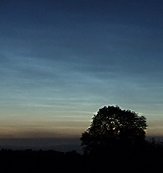
|
Martin Mc Kenna,
Maghera, Co. Derry, N. Ireland
Jun. 5, 2009 |
#1,
#2,
#3,
#4,
more |
This is now
the 3rd night in a row of NLCs I have seen from N. Ireland
so far this season. This was another huge display glowing
electric blue all night long until dawn washed it from the
sky. The changing structure was too difficult to describe
along its entire 120 degree length. A line of dark convective
'normal' clouds arrived in and looked great in contrast
with the glowing NLCs above. A great show.
Photo
details: Fujifilm S6500fd. Various settings. |
|
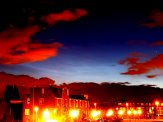
|
Bouic Damien,
Rotterdam, the Netherlands
Jun. 5, 2009 |
#1, #2, more |
Second time
of seeing NLC from Rotterdam. They were more bright than
the first. A lot of stratus on the ground masked a part
of the view, but in the holes, the NLCs were very clear.
Photo
details: Kodak Easyshare ZD710 |
|
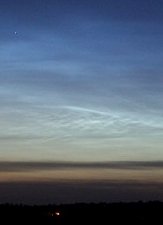
|
John
C. McConnell,
Maghaberry Northern Ireland.
Jun. 5, 2009 |
#1,
#2,
#3,
#4 |
They
just keep getting better! Two night's in a row now we have
had fantastic displays of NLC's. This was easily the best
so far and one of the brightest I've ever seen so early
in the season.I can't wait for the rest if this is anything
to go by.
Photo
details: Canon
400D, 18-55mm lens, 6 to 10 seconds, ISO800. |
|
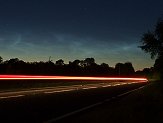
|
Martin
Mc Kenna,
Maghera, Co. Derry, N. Ireland
Jun. 4, 2009 |
#1,
#2,
#3,
#4,
more |
We
just had another high quality NLC display here in N. Ireland
which lasted for much of the night. This one took up the
NW to E of N sky and had great electric blue colours which
contrasted with the green and silver hues from the belly
of the display, all visible against the stars of Auriga,
Perseus, and Andromeda. Great structures visible = bands,
whirls, herringbone, veil etc all at the same time. I can't
wait to see the major displays over the next few weeks if
this is what we are getting now!
Photo
details: Fujifilm S6500FD 6.3MP various settings.
|
|
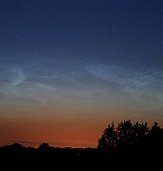
|
John
C. McConnell,
Maghaberry Northern Ireland.
Jun. 4, 2009 |
#1 |
Tonight we have
had our first really beautiful display of NLC's this season,they
have really taken off now! This display started just after
twilight ended and lasted until 03:00UT. This is one image
from the many taken but shows what a beaut it was.
Photo
details: Canon
400D, ISO800, 8-10 seconds. |
more
images: from
Paul Evans of Larne, Northern Ireland; from
Martin Mc Kenna of Maghera, Co. Derry, N. Ireland; from
John C Mcconnell of Maghaberry Northern Ireland; from
Aurimas Dirse of Vilnius, Lithuania;
|
|
|






